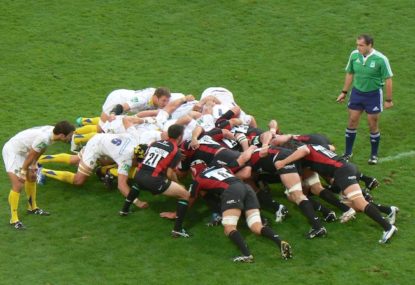If Australia is looking for big men, let's not neglect the old and the fat
Three things in the world of rugby have caught my eye this week, and got me thinking very hard about the way forward, and…

Thank God it’s over. For the European rugby player, the end of February is an unofficial public holiday, as it means that the harsh, relentless darkness of winter has shut it’s curtains for another year.
It’s a time for unwavering celebration, as we happily part ways with our thermals, look forward to seeing our calves again, and can now literally see the light at the end of the tunnel.
It also means a return to the pitch for training.
To keep the field playable for each weekend’s game, and to manage the mental state of the groundsman (who rarely smiles during this time of year), we’ve been kicked out of our own home.
For the past three months, we’ve been sent every which way to complete our sessions; an indoor University basketball court one day, a primary-school playground the next.
It’s all to no avail though, as come the weekend the playing pitch is reminiscent of a West Country family farm, with potholes big enough to sink your ankles in thanks to the non-stop rain that’s been hammering its surface.
We can’t complain though. No, we are rugby players, built to withstand all sorts of conditions. We will go out there into battle, brave the mud, wind and rain, then wash it all off with a cold shower afterwards.
However, wouldn’t it be nice to be able to play on a pitch that remains in pristine condition, week in, week out, regardless of the weather?
Where kickers would rarely lose their footing, crowds are entertained with vintage southern-hemisphere running rugby, and heaven forbid, a scrum might be completed without collapsing five times beforehand?
For clubs like London Saracens and Cardiff Blues, this luxury is a reality. Both clubs have invested heavily in artificial 4G match day pitches, and from what we have seen, are reaping the rewards that playing on a consistent pitch brings.
I believe that other European clubs should follow the pathway in opting for artificial surfaces, as evidence has shown there are huge benefits for both player and spectator.
I can hear all you traditionalists and purists moaning and shaking your head at the back of the grandstand. “Ridiculous” you might say, “this is not American football!” And six months ago, I would have agreed with you.
My skepticism was threefold.
Firstly, I loved the unpredictability of the weather and embraced the fact that the elements and outside factors are part and parcel of the game. They force the player to adapt, and require a greater skill set, ultimately improving your awareness and ability.
Secondly, as a player who has had a history of knee injuries, I questioned the impact of a harder surface on my joints. Would the constant jarring of my bones be like running on the road?
Finally, I had an issue with the fairness of only a couple of clubs having the advantage of access to the 4G pitches.
Why should they play every home fixture on a surface more conducive to achieving try bonus points, while others battle it out in a penalty shoot-out and once a year get the chance to play on their hallowed turf?
After witnessing Saracens and Cardiff compete in the first half of the English premiership and Pro 12 respectively, and hearing the comments of opposition clubs who visited their grounds, I’ve become an artificial convert, and believe that it’s the way forward for European rugby, even if only two of my three hesitations were answered.
After spending the best part of the past five years in the United Kingdom, I realise that the weather will always be an issue, and future forecasts show that it ain’t getting any better. There is still wind and rain regardless of the surface you play on, so players have to adapt.
Having an artificial pitch means fewer games will be postponed, and supporters witness a faster game where the hits are still as big and the contest as fierce.
The injury statistics of games played on 4G pitches also put my mind at ease. There was no indication that playing on this surface would increase the risk of injury nor put excess strain on joints that were deteriorating.
The combination of a sand and rubber infill on astro turf pitches means a sympathetic surface where the body is under no more stress than it would be on a grass track.
The only issue that I have is that not every club has the funds to afford a 4G pitch. It’s like a Formula One team having access to the latest top-of-the-range engine, while the others play catch up with their standard motor.
In the modern game, where clubs and individuals are always looking for the one-percenters, where success or defeat can come down to minute details, having a 4G pitch is a massive advantage.
However, having a 4G pitch doesn’t win you matches, made evident by Cardiff languishing in the bottom half of the ladder, while Saracens continued success began well before this year.
Ultimately, you can change the surface, but you can’t change the player. Rugby matches will always be decided by that one bit of skill, that big hit, or that unfortunate error, regardless of the environment the game’s played in.
That’s the beauty of our great game.